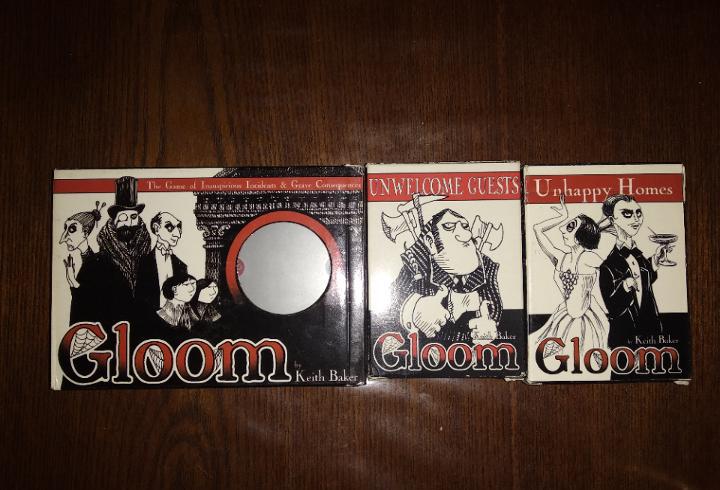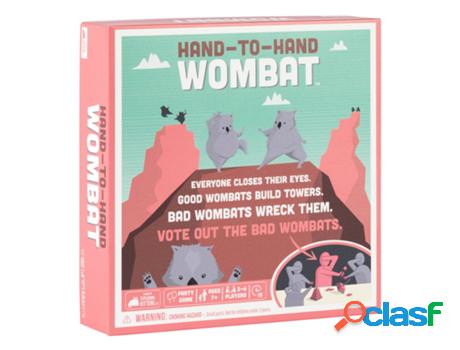Jayne are three player game
Listado top ventas jayne are three player game

España
Tricky blocks: a wobbly stacking game for 2 to 6 players aged three years upwards.the six gaily coloured building blocks combine to form a foundation base for six wonky towers which need to be built higher and higher. not exactly an easy task as the building blocks required to be placed on top are all bent and crooked! the player erecting the highest tower is declared the winner!content: 6 coloured building blocks, 12 small wobble blocks, 6 large wobble blocks, 1 coloured dice.game tricky blocks, a wooden game made in germany by erzi.
Ver producto

Madrid (Madrid)
Saboteur (English Edition) Saboteur (English Edition) Players take on the role of dwarves. As miners, they are in a mine, hunting for gold. Suddenly, a pick axe swings down and shatters the mine lamp. The saboteur has struck. But which of the players are saboteurs? Will you find the gold, or will the fiendish actions of the saboteurs lead them to it first? After three rounds, the player with the most gold is the winner. With the help of Dwarf Cards, the players are assigned their role: either miner or saboteur. The roles are kept secret- they are only revealed at the end of the round. The Start Card and the three Goal Cards are placed onto the table, each seven cards away from the start and one card between each Goal Card. The Goal Cards are placed face-down. The gold is on one of the Goal Cards, but nobody knows which. Players have cards in hand. On a player's turn, he must do one of three things: place a Path Card into the mine, play an Action Card in front of a player, or pass. The Path Cards form paths leading to the Goal Cards. Path Cards must be played next to a already-played Path Card. All paths on the Path Card must match those on the already-played cards, and Path Cards may not be played sideways. The miners are trying to build an uninterrupted path from the Start Card to a Goal Card, while the saboteurs are trying to prevent this. They shouldn't try and be too obvious about it, however, lest they be immediately discovered. Action Cards can be placed in front of any player, including oneself. Action Cards let the players help or hinder one another, as well as obtain information about the Goal Cards. Once a player places a Path Card that reaches the gold, the round is over. The miners have won and receive cards with gold pieces as their reward. The round is also over if the gold could not be reached. In that case, the saboteurs have won and receive the gold pieces. Once the Gold Cards have been distributed, the next round begins. The game is over at the end of the third round, with the player with the most gold pieces being the winner.
Ver producto

España
JOGO ORIGINAL EM INGLÊS: In Ora et Labora (Latin for 'Pray and work'), each player is head of a monastery in the Medieval era who acquires land and constructs buildings – little enterprises that will gain resources and profit. The goal is to build a working infrastructure and manufacture prestigious items – such as books, ceramics, ornaments, and relics – to gain the most victory points at the end of the game. Ora et Labora, Uwe Rosenberg's fifth big game, has game play mechanisms similar to his Le Havre, such as two-sided resource tiles that can be upgraded from a basic item to something more useful. Instead of adding resources to the board turn by turn as in Agricola and Le Havre, Ora et Labora uses a numbered rondel to show how many of each resource is available at any time. At the beginning of each round, players turn the rondel by one segment, adjusting the counts of all resources at the same time. Each player has a personal game board. New buildings enter the game from time to time, and players can construct them on their game boards with the building materials they gather, with some terrain restrictions on what can be built where. Some spaces start with trees or moors on them, as in Agricola: Farmers of the Moor, so they hinder development until a player clears the land, but they provide resources when they are removed. Clever building on your personal game board will impact your final score, and players can buy additional terrain during the game, if needed. Players also have three workers who can enter buildings to take the action associated with that location. Workers must stay in place until you've placed all three. You can enter your own buildings with these workers, but to enter and use another player's buildings, you must pay that player an entry fee so that he'll move one of his workers into that building to do the work for you. Ora et Labora features two variants: France and Ireland.
44,79 €
Ver producto

Madrid (Madrid)
Colección Gloom (básico + 2 expansiones; edición en inglés) Colección Gloom (básico + 2 expansiones; edición en inglés) The world of Gloom is a sad and benighted place. The sky is gray, the tea is cold, and a new tragedy lies around every corner. Debt, disease, heartache, and packs of rabid flesh-eating mice—just when it seems like things can't get any worse, they do. But some say that one's reward in the afterlife is based on the misery endured in life. If so, there may yet be hope—if not in this world, then in the peace that lies beyond. In the Gloom card game, you assume control of the fate of an eccentric family of misfits and misanthropes. The goal of the game is sad, but simple: you want your characters to suffer the greatest tragedies possible before passing on to the well-deserved respite of death. You'll play horrible mishaps like Pursued by Poodles or Mocked by Midgets on your own characters to lower their Self-Worth scores, while trying to cheer your opponents' characters with marriages and other happy occasions that pile on positive points. The player with the lowest total Family Value wins. Printed on transparent plastic cards, Gloom features an innovative design by noted RPG author Keith Baker. Multiple modifier cards can be played on top of the same character card; since the cards are transparent, elements from previously played modifier cards either show through or are obscured by those played above them. You'll immediately and easily know the worth of every character, no matter how many modifiers they have. You've got to see (through) this game to believe it! Each of the three expansions for Gloom adds one more player, thus with all three expansions, this should be playable with seven players.
Ver producto

España
JOGO ORIGINAL EM INGLÊS: A tabletop card game about sacrifice, betrayal and hoarding. Inspired by the hit video game Binding of Isaac, the official card game was launched on Kickstarter in June 2018. Four Souls starts by giving each player their character cards, item cards, three loot cards, and coins. Play goes from player to player as each choose to play loot cards, buy items from the store, or attack monsters! The first player to obtain four souls reigns supreme. Are you ready to tackle The Bloat and other evil adversaries? Experience the haunted and harrowing world of The Binding of Isaac: Four Souls. In this faithful adaptation of the smash-hit video game, players will collect treasure, gather loot and defeat monsters to help themselves to win, or to hinder their opponents. With over 300 cards to play with, theres a huge amount of replay-ability as players discover new combos of cards and abilities each game in their race to be the first player to acquire Four Souls!
Ver producto

España
Juego Original en Inglés: Mortum: Medieval Detective is a game of deduction and adventures that takes place in a grim world shaped in the image of medieval Europe, with its legends, superstitions and fears coming to life. Take on the roles of secret organization agents and investigate mysterious and thrilling events. You will solve mysteries and encounter fascinating characters in the course of three exciting scenarios, all part of a single storyline. Each case requires up to three hours to play. You are free to explore the world of Mortum in any way you like, depending on which agents you chose. Put objects under surveillance or send agents to secretly search or interact with them in many other ways. Gather information by interrogating suspects or talking to them. Choose your own way to advance through the game, either using the kick in the door approach or by being stealthy and discrete, trying to avoid unwanted attention. During each turn, a player chooses one of the cards available this turn. These cards can represent a Clue, a Location, Witness Interrogation, etc. Using the cards and Special Action, which were received during investigation, a player discovers what actually happened. Only you and the choices you make decide how the events will unfold in the end. Tread carefully, and welcome to Mortum!
48 €
Ver producto

España (Todas las ciudades)
Axis & Allies D-Day features detailed game components including a new blockhouse piece and an oversized game board. Other elements of this new Axis & Allies variant include a card deck with three card types -- Orders, Tactics, and Fortune -- adding depth and complexity to gameplay. Order cards determine play sequence and break turns into distinct phases; Tactics cards offer players varied strategic opportunities; and Fortune cards add an element of unpredictability. Axis & Allies D-Day begins as Operation Overlord, the invasion of German-held Normandy -- 130,000 soldiers of the United Kingdom, Canada, and the United States poise to assault Fortress Europe. You and your fellow world powers control their fates. One player controls Germany, whose Axis forces have turned the beaches of Normandy into a near-impenetrable stronghold. Set to breach those defenses are the Allies: the United Kingdom, Canada, and the United States. Axis & Allies D-Day, designed for two or three players, can be played in two hours. The game is the third Axis & Allies variant, following the successful Axis & Allies Europe and Axis & Allies Pacific.
40,45 €
Ver producto

España
Jogo original em inglês: to play hand-to-hand wombat, youre each given a secret identity as a good wombat or a bad wombat, then everyone closes their eyes. good wombats build towers; bad wombats try to mess with those towers. after the timer is up, everyone opens their eyes and discusses, argues, and votes on who they think is a bad wombat. hand-to-hand wombat is like thumb wrestling combined with mind wrestling. at the beginning of the game, you're given a role card: you'll either be a good wombat or a bad wombatthe game pieces are then scattered around the table.everyone closes their eyes while manipulating the pieces simultaneously. the good wombats are trying to build the three pyramidal towers in an orderly fashion whereas the bad wombats will try to cause chaos by deconstructing the towers or by ruining the pyramidal shapes.when the timer runs out, everybody stops, open their eyes, discuss what just happened and votes to cast a player out of the game.the good wombats win if they successfully build the towers before too many of their teammates have been eliminated. otherwise the bad wombats win.
28,79 €
Ver producto
